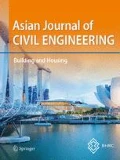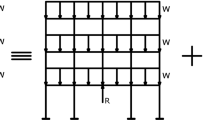Abstract
Progressive collapse refers to a phenomenon in which a local damage in a primary structural element due to abnormal loads, leads to a partial or complete structural failure. Although most studies in progressive collapse are based on deterministic analysis using median or nominal values of analysis parameters, uncertainty analysis also results in more realistic results. An application of probability theory to the structures’ failure analysis with uncertain properties is one of the ways to deal with, in which they are considered as random variables. For probabilistic analysis, first sensitivity analysis should be carried out to study the sensitivity of response to different parameters. In this paper, sensitivity analysis is performed to study the effect of uncertainty of dead and live loads, and properties of steel such as modulus of elasticity and yield stress of steel on the response of column removed point. Then, fragility curves are also plotted to investigate the probability of progressive collapse of steel moment frames.


















Similar content being viewed by others
References
Asprone, D., Jalayer, F., Prota, A., & Manfredi, G. (2010). Proposal of a probabilistic model for multi-hazard risk assessment of structures in seismic zones subjected to blast for the limit state of collapse. Structural Safety, 32, 25–34. https://doi.org/10.1016/j.strusafe.2009.04.002.
Bucher, C. G. (1988). Adaptive sampling—an iterative fast monte- carlo procedure. Structural Safety, 5, 119–126. https://doi.org/10.1016/0167-4730(88)90020-3.
Department of Defense (DOD). (2013). Unified facilities criteria (UFC): design of buildings to resist progressive collapse. Washington (DC).
Ellingwood, B. R. (2006). Mitigating risk from abnormal loads and progressive collapse. Journal of Performance of Constructed Facilities., 20(4), 315–323. https://doi.org/10.1061/(asce)0887-3828(2006)20:4(315).
General Service Administration (GSA). (2003). Progressive collapse analysis and design guidelines for new federal office buildings and major modernization projects. Washington (DC).
Harris, M. E., Corotis, R. B., Bova, C. J. (1981). Area-dependent processes for structural live loads. Journal of Structural Division, 107(ST5).
Izzuddin, B. A., Vlassis, A. G., Elghazouli, A. Y., Nethercot, D. A. (2008). Progressive collapse of multi-storey buildings due to sudden column loss-Part I: simplified assessment framework. Eng. Struc. 30, pp. 1308–1318, https://doi.org/10.1016/j.engstruct.2007.07.011.
Kim, J. R., Kim, S. B., Park, Y. H., & Chung, W. G. (2000). Statistical investigation on material properties of steel. Conf Arch Inst Korea, 20(1), 229–232.
Kim, J., Lee, Y., & Choi, H. (2011a). Progressive collapse resisting capacity of braced frames. The Structural Design of Tall and Special Buildings, 20, 257–270.
Kim, J., Park, J. H., & Lee, T. H. (2011b). Sensitivity analysis of steel buildings subjected to column loss. Engineering Structures, 33(2), 421–432. https://doi.org/10.1016/j.engstruct.2010.10.025.
Krawinkler, H., Gupta, A., Luco, N., and Medina, R. (1999). SAC Testing Programs and Loading Histories, part of FEMA SAC Phase II project. NISEE—University of California at Berkeley.
Le, J. L., Xue, B. (2013). Probabilistic analysis of vulnerability of reinforced concrete buildings against progressive collapse, Structures Congress, ASCE.
Lee, C., Kim, S., Han, K., & Lee, K. (2009). Simplified nonlinear progressive collapse analysis of welded steel moment frames. Journal of Constructional Steel Research, 65, 1130–1137. https://doi.org/10.1016/j.jcsr.2008.10.008.
Lee, T. H., Mosalam, K. M. (2006). Probabilistic seismic evaluation of reinforced concrete structural components and systems. PEER Technical Report 2006/04. Berkeley: University of California.
Li, Q., & Ellingwood, B. R. (2007). Damage inspection and vulnerability analysis of existing buildings with steel moment-resisting frames. Engineering Structures. https://doi.org/10.1016/j.engstruct.2007.03.018.
Melchers, R. E. (1999). Structural reliability analysis and prediction. Chichester: Wiley.
Metropolis, N., & Ulam, S. (1949). The Monte Carlo method. Journal of the American Statistical Association, 44, 335–341. https://doi.org/10.1080/01621459.1949.10483310.
Naji, A. (2016). Modeling catenary effect in progressive collapse analysis of concrete structures. Structural Concrete, 17(2), 145–151. https://doi.org/10.1002/suco.201500065.
Naji, A., & Irani, F. (2012). Progressive collapse analysis of steel frames: simplified procedure and explicit expression for dynamic increase factor. International Journal of Steel Structures, 12(40), 537–549. https://doi.org/10.1007/s13296-012-4008-0.
Nowak, A. S., Collins, K. R. (2000). Reliability of structures, McGraw-Hill.
Porter, K. A., Beck, J. L., & Shaikhutdinov, R. V. (2002). Sensitivity of building loss estimates to major uncertain variables. Earthquake Spectra, 18(4), 719–743. https://doi.org/10.1193/1.1516201.
Ruth, P., Marchand, K. A., & Williamson, E. B. (2006). Static equivalency in progressive collapse alternate path analysis: reducing conservatism while retaining structural integrity. Journal of Performance of Constructed Facilities, 20(4), 349–364. https://doi.org/10.1061/(ASCE)0887-3828(2006)20:4(349).
Schudler, G. I. (1997). Structural reliability—recent advances, 7th International Conferences on Structural Safety and Reliability, Kyoto, Japan.
Tsai, M., & Lin, B. (2008). Investigation of progressive collapse resistance and inelastic response for an earthquake-resistant RC building subjected to column failure. Engineering Structures. https://doi.org/10.1016/j.engstruct.2008.05.031.
Uniform Building Code, UBC. (1997). In International Conference of Building Officials, Whittier, CA.
Vamvatsikos, D., & Cornell, C. A. (2002). Incremental dynamic analysis. Earthquake Engineering and Structural Dynamics, 31(3), 491–514. https://doi.org/10.1002/eqe.14.
Vlassis, A. G., Izzuddin, B. A., Elghazouli, A. Y., & Nethercot, D. A. (2008). Progressive collapse of multi-storey byildings due to sudden column loss-Part II: application. Engineering Structures, 30, 1424–1438. https://doi.org/10.1016/j.engstruct.2007.08.011.
Author information
Authors and Affiliations
Corresponding author
Rights and permissions
About this article
Cite this article
Naji, A. Sensitivity and fragility analysis of steel moment frames subjected to progressive collapse. Asian J Civ Eng 19, 595–606 (2018). https://doi.org/10.1007/s42107-018-0045-0
Received:
Accepted:
Published:
Issue Date:
DOI: https://doi.org/10.1007/s42107-018-0045-0




